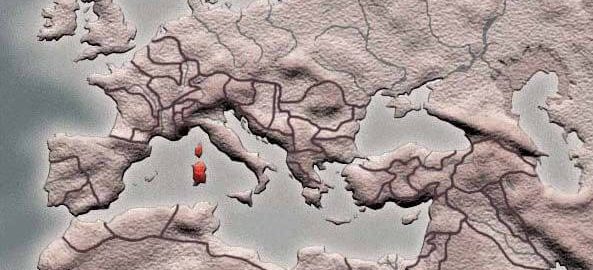Chapters
Corsica and Sardinia (Sardinia et Corsica) were originally not of interest to the Romans, as their expansion was based on the Apennine Peninsula. Rome, first as a monarchy and then as a republic, was a typical land state. By contrast, Carthage pursued economic and political conquest in the Western Mediterranean without thereby interfering with the interests of the “Eternal City”.
Pre-Roman period
Both Sardinia and Corsica have been inhabited by local civilizations since the beginning of the first millennium BCE. There was a nuragic culture in Sardinia, and a torri culture in Corsica – both named after the preserved characteristic towers; nuraghi and torri respectively.
Originally, the Phoenicians established their trading settlements in Sardinia and the Greeks in Corsica; this is how important centres of both islands were created – for example, Alalia in Corsica and Olbia in Sardinia.
Sardinia and Corsica were under the Carthaginian influence as early as the end of the 6th century BCE. The gradual colonization of the islands was carried out until the middle of the 4th century BCE; it was then intensified when numerous forts and defensive structures were built.
Roman influence on the islands
The situation changed when the First Punic War broke out in 264 BCE, and after more than 20 years of struggle, Carthage had to recognize Rome’s superiority. On the base of a room in 241 BCE, Sardinia and Corsica remained under Carthage’s influence. However, the huge war contributions imposed on the Carthaginian state and the problems with paying them back resulted in a mercenary uprising in Carthage. The complicated internal situation of the former enemy was used by the Romans, who, having acquired the skills of sea combat and operating offshore, invaded in 238 BCE. Sardinia and Corsica. Carthage, exhausted from earlier struggles with Rome and internal struggles, finally recognized the sovereignty of the Romans over the islands.
Officially, Sardinia and Corsica were recognized as new Roman provinces in 227 BCE. The process of the conquest of Sardinia and Corsica by the Romans, however, de facto lasted much longer, because the local population, living especially in the central parts of the islands, put up stiff resistance to the Romans. What you should pay attention to is the occupant’s approach to local residents. The Carthaginians established their colonial centers on the coasts of the islands, leaving control over areas farther from the sea to the local population. What’s more, the Punics agreed to trade with local residents, therefore there was a certain coexistence. The Romans, in turn, waged a full-scale offensive and attempted to subjugate entire islands. In addition, the population was slaves to them, which additionally aggravated the conflict.
During the Second Punic War, there was the first major Sardinian rebellion (Bellum Sardum) against Rome. The victories of Hannibal in Italy spurred the people of Sardinia to revolt in 215 BCE. The uprising was led by a certain Hampsykor, a local landowner who united the tribes of the island. Carthage, wanting to take advantage of the situation and remove Roman influence from Sardinia, decided to send Punic troops under the command of Hasdrubal to help. The Roman Senate, in turn, sent Titus Manilius, who had two legions under his command. Originally, the Sardinians had to fight alone, but when the Carthaginians landed on the island, a battle took place near the city of Cornus (central-western Sardinia). The defeat of the Carthaginians and the rebels calmed the situation for some time and, above all, thwarted the further dreams of the Punics to get involved in the problems of Sardinia.
The last major rebellion of the Sardinians against the Romans broke out in 178 BCE. It was then that the troops of Tiberius Sempronius Gracchus defeated the insurgents. However, the battles were fought with less intensity until 111 BCE.
In general, any resistance of local residents to the Roman rule ceased in the 1st century BCE, when the islands and their material potential were used in subsequent civil wars. The coastal communities who saw the benefits of cooperation with the Romans were the first to be pacified/romanized. However, the mainly mountainous people still had a hidden hatred of the Romans.
In 27 BCE Octavian Augustus divided the provinces into those under the administration of the Emperor and those under the control of the Senate. Sardinia and Corsica fell into the hands of the senators. From the 1st century CE, we can already speak of two separate provinces, which finally in 292 CE they were attached to the Diocletian of Italy created by Diocletian.
Economic importance
Both islands supplied the capital mainly with: salt, grain, wine, oil, and the mineral deposits made it possible to replenish the resources of silver, iron and copper. Sardinia stood out as one of the most important grain suppliers, especially in the time of the Republic; Corsica, on the other hand, was the main wax exporter.
Sardinia was also one of the most important places in the Empire, where sailors were recruited and slaves were acquired; interestingly in Rome, bad words were uttered about slaves from Sardinia, as disobedient and ready to kill their master if there was a chance.







